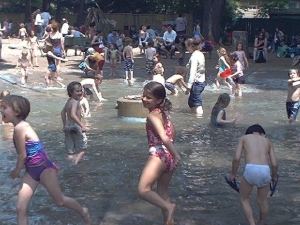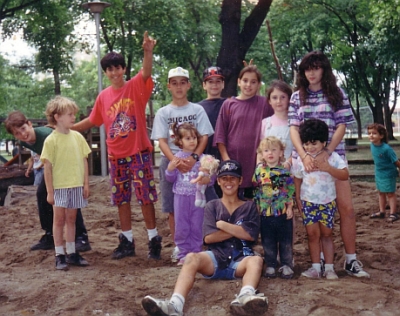Controls: show
 Document
Document
 Comments:
Comments:
[log in] or [register] to leave a comment for this document.
Go to:  all documents
all documents
Options: show
Path:
Looking inside:
 Jutta Mason: Parks story
Jutta Mason: Parks story
( display item 1)
display item 1)
Contact:
Website:
[home] [about] [help] [policies] [legal disclaimer]
Subsites:
 documents
documents topics
(or
topics
(or  site menu)
site menu)
 blogs
(or
blogs
(or  posts)
posts) library resources
(including
library resources
(including  pictures)
pictures) database (all)
database (all)
Members:
 Document
Document
 ·1·
Chapter one
·1·
Chapter one
Trouble: a new recreation supervisor arrives on the scene 18-Jan-2012 [934]
Part of
 Jutta Mason: Parks story
Jutta Mason: Parks story
A summer serial, July 7, 2011: Chapter One.
Jutta Mason
A new recreation supervisor, Wendy Jang, has been assigned to Dufferin Grove Park. In early June, Wendy summoned the park’s recreation staff to several long meetings during which she wanted them to outline exactly who does what, in fifteen-minute increments. Prior to this, Wendy spent most of her career in North York. She said she found Dufferin Grove very different from parks she was used to. So she wanted the staff to explain the details. But the park is a very busy place, and breaking down everyone's responsibilities into finite bits with clear boundaries didn't really match reality. When the staff’s answers didn’t satisfy her, Wendy soldiered on by herself. She spent many hours writing lists and reallocating staff, in a way that made more sense to her than the work schedule that had been developed by trial and error at the park. Then she told the staff that they must follow her schedule instead.
At the end of July there will be a meeting between Kelvin Seow, the manager of Toronto/East York Recreation, and me, Jutta, the administrator of our small research group. The group is called Centre for Local Research into Public Space, or CELOS. The subject of the meeting is an internal ‘Briefing Note’ to arrange the transfer what the Note calls “Skating and Food Services” at Campbell Rink and Wallace Rink to Parks, Forestry, and Recreation (PFR) from CELOS this coming fall. Kelvin says that will be followed by “a two-year process to assume full operation of programming at Dufferin Grove Park and Community Centre.”
In preparation for the meeting, we asked to see the Briefing Note, but we had to get it through Freedom of Information, since Kelvin was not willing to show it to us. It describes the activities of CELOS as mainly running “concession stands” and skate rental operations. According to the Briefing Note, if Dufferin Grove continues to operate as it has been doing all these years, “the City will be non-compliant on many approved policies, procedures, and legislative requirements… ...vulnerable and open to major risk factors.”
Beginning this fall, then, there is to be a phased-in “Action Plan to assume operations.” But in fact, the new supervisor has begun the Action Plan already, just as the summer is starting.
One of the things the supervisor wanted to fix first was the staffing of the two wading pools that Dufferin Grove recreation staff look after (Dufferin Grove and MacGregor Park). She said that as of this summer, the wading pool staff are supposed to focus solely on monitoring wading pool water quality and watching for risky behaviour. No other skills are required of them.

That’s a big change for the park. At Dufferin Grove, the wading pool staff have always alternated with each other, doing many of the other park tasks as well – preparing food for the cafe, serving at the weekly community suppers, fixing broken slats on the park benches, scheduling summer camp pizza visits, setting up farmers for the Thursday market, working with the garden volunteers, keeping the sandpit safe and fun...on and on. The variety of tasks and the way the activities build on one another is one reason why the park has attracted such a range of interesting and capable part- time workers over the years.
All the other tasks at the park are also being separated. The person setting out the shovels in the sandpit can’t go up to the rink clubhouse kitchen and bake cookies, and then work with the seniors’ group to weed the garden. Those are all separate jobs – little separate silos.
Management wants to go back, the supervisor wrote in an e-mail to CELOS, to the core activities that parks and recreation has traditionally run. That is why, this summer, she is dissecting out the traditional services of the PFR Division from “programs that represent anomalies for PFR.”
Her point raises an interesting question: what are the traditional activities in Toronto’s parks and playgrounds?
A visit to the City Archives turns up lots of material. Back in the first two decades of the twentieth century, the “playground movement” began to transform parks in the United States and Canada. Thousands of newcomers were arriving by boat and the cities were growing fast. Where would all the children play, and how would they and their families integrate into their new society?
Parks with lively playgrounds seemed like a good way to bring people together. In Toronto, the city government worked with public-spirited citizens to set up playgrounds and hire park staff to make some fun for the children, and for their parents too. The Toronto archives have records of numerous park events in the early 1920’s: picnics for girls, family entertainments and public lectures, folk dance competitions (at Osler Park on Argyle, and Moss Park on Shuter Street), a “working boys” billiard tournament at McCormick Park, a wrestling championship, a costume competition for the “annual carnival of the city playgrounds” at Moss Park rink with skaters in costumes. There were many athletic meets for both girls and boys. For example, in 1923, the Parks Department held a City Playgrounds Girls’ Athletic meet. It was described in the papers as “probably the largest of its kind ever held in Canada.” There were 324 girls participating in numerous events, plus another 310 girls who competed in prior elimination rounds. There were more contestants in the girls’ meet than in the boys’.
Another example, April 16, 1925: city playgrounds held their annual treasure hunt. 114 boys from East Riverdale, McCormick, Lansdowne, Moss Park and Carlton Park started at the College Street High Park entrance at 10 a.m. to hunt for 30 hidden clues.
“The trail led westward through High Park to Swansea where a stop was made for refreshments after the first hour of climbing the hills. The hunt then continued westward over the Old Belt Line to the Humber Valley; then northward to the Camping Grounds above Bloor street where the last Treasure was hidden. A fire was built and soon hungry boys were watching the hot dogs roasting, potatoes boiling, baking or burning. After eats, the boys were divided into three groups according to ages and football, baseball and active games were engaged in until the boys were tired out. The boys sat on the bank and watched the fishermen catch suckers after which the happy, tired crowd wended its way homeward.”

By 1934 the Parks Department employed 207 “playground supervisors” in the summer and 219 (181 part-time) in winter, whose task it was to engage with the children. A playground in the 1930’s typically had 6 big swings, 4 baby swings, a tether tennis pole, a sandbox, 4 see-saws, and one children’s slide. It also had a supply box with “footballs, baseball, bats, industrial work [crafts] supplies, etc.” The playgrounds with wading pools were at Alexandra Park, Dovercourt Park, Earlscourt Park, Monarch Park, Moorevale Park, Ramsden Park, and Withrow Park. There were girls' competitive teams as well as boys, in baseball, basketball, hockey, and volleyball. In 1931 there were 2,750 boys in the City Playgrounds athletics championship competition and 3,025 girls. The Toronto archives photo collection from that time has many hundreds of team photos, of both sexes, as well as action shots of folk dancing displays, children's gardening groups, and skating and sledding groups on frozen rivers.
But by the early 1930’s, Parks management's rules for playground staff began to calcify. The children using the playgrounds were segregated by sex, and paperwork played an important part: Here are Parks Commissioner S.H.Armstrong’s 1932 rules for playground supervisors:
“Rain or shine, playgrounds are supervised just the same and all apparatus ready for use…As soon as the supervisor goes on duty, she hangs baby swings, unlocks slide and teeters and puts out pails and shovels….In the wading pool, wading only is allowed; no regulation bathing suits; or old clothes used as bathing suits; no change of clothes. If children get clothing wet then out they come. Children 5 years and under may wear sun suits… Lady supervisor does not give any equipment to boys, on man’s morning off or any other time.” The lady supervisor got one evening off one week, then in alternate weeks she got two evenings off. Otherwise she worked until 8.30 p.m., whereas the man worked until dark. Both man and lady supervisors had to fill out daily reports, which included census and “dramatic story telling, when taken.”
By the 1940's, the variety and fun of earlier Toronto playgrounds seem to have almost dried up. There were only three wading pools left. A critical survey done in 1943 said that kids seemed to prefer to play in lanes, on lawns, verandahs, on the roads, in garages, around old factory buildings – anywhere but city playgrounds. Playground supervisors were said to be very rule-bound. One example was Central Tech playground. It was for boys only and baseball only.
“If girls come and ask for equipment to play ball, they can’t have it. In a playground where girls can play baseball, no boys can come and watch.”
The younger supervisors were scared to break rules because they’d get fired. But the older ones broke the rules anyway. A senior supervisor told the interviewer:
“When I am supplying at Alexandra Park wading pool I let the kids get soaking wet toward the end of each evening. If the head supervisor came around I would have to admit a failure to observe the rules, but the kids have a whale of a good time.”
Most playgrounds had no shade, no grass, just lots of dirty cinders and cement. Playgrounds had footballs but the boys were not allowed to use them in July – that was supposed to be baseball month. In August they could use footballs but not baseballs. Bean bags were not allowed to be used by older boys – only up to seven.
“Suggestions made to the immediate supervisor do not get far. The supervisor says, ‘The boss will not agree’ and that is the end of that.”
Many playgrounds were deserted.
Then in the decade after the end of the Second World War there was an effort to build the playgrounds up again. The only wading pools left by 1955 were Dufferin (donated in 1954 by the son of Abe Orpen, the Dufferin Park racetrack owner), Kew (1953) and Wanless Park (1953). The post-war management aimed to change that. The new Metropolitan Toronto Parks Commissioner, Tommy Thompson, told a Garden Club meeting in 1955 that he
“visualized large, easy-going areas with outdoor cooking equipment, plenty of toilet facilities, breathing room for family parties or large and small groups, and ready accessibility.” He also said that sand play areas for children should be large: "I passed a playground the other day in which I saw a sandbox that I suspect was twelve feet square. To me, this is an insult to the sand area concept. The time has come when we've got to get bigger in our thinking and realize that, when a group of kids want to carry out something that stimulates their imagination - and this is one of the things we should be responsible for promoting - we should be putting in a sand area half as big as this auditorium. We should be putting in the kind of sand that kids can use to build, and we should not only keep it clean every day, but make sure that it's moist enough to do something with…”
In the 1950’s, Toronto’s Parks Department put in 18 new wading pools, and 6 new playgrounds. By 1962, the number of wading pools had increased again, to 53. The staff of the 172 city playgrounds began their spring programming on May 18 that year, long before the summer holidays.
By the time our former Ward 18 supervisor Tino DeCastro started working at Dufferin Grove as his first summer job in the early 1980’s, the playgrounds were once again filled with kids and families. Dufferin Grove’s playground had five staff, two of them “play leaders” who did games and crafts and outings with the children. The programs ran from 9 a.m. to 9 p.m. Even tiny parkettes had play staff. Playgrounds competed with one another in soccer and baseball meets. The field houses became neighbourhood clubhouses, with the walls inside as colourfully painted with children’s art and graffiti as prehistoric caves were painted with hieroglyphics.
Toward the end of the 1980’s, this development also began to fade. Children gradually disappeared off the streets and out of the playgrounds as their parents felt the need to place them in closely supervised camps during holidays. In 1993, Dufferin Grove Park had three teenage staff at the wading pool, but the playground was often pretty empty.

sandpit 1994
That year an old-fashioned sand pit play area was proposed for Dufferin Grove, and a few artists were hired (with a donation from Dufferin Mall) to do activities with the kids. Some of the immediate park neighbours were not happy about the sand pit, and they stood in front of the bulldozer to block it when it came to dig. They said they didn’t want more activity in the playground. But the very hands-on Recreation director at the time, Mario Zanetti, came to the park himself, to make a pitch. He got up on a picnic table in front of the crowd and asked the opposition to give the sand play area a chance. One by one, parents from the neighbourhood came forward to the picnic table and spoke in support of his request. Those in opposition withdrew, and the “Big Backyard” adventure playground got its start, with arts and food and extra support for the families who came back to using the playground.
Now, eighteen years later, the lively scene around the adventure playground is one of the elements of the park that is under threat of being taken apart, for not being part of the “traditional” activities of PFR.
The fact is – as this little history shows – most of the traditional activities in Toronto’s playgrounds were stopped some time ago. Where are the plentiful in-house sports leagues and athletic meets? Toronto’s recreation staff no longer run any house leagues or tournaments. Where are the staff-run festivals and folk dancing competitions? None are left. And the cross-city treasure-hunt with roasted potatoes over a campfire? Long gone. The pick-up football games organized by the play leaders, or the storytelling sessions? No longer part of the city's “approved organizational standards.” PFR management has itself eliminated most of the traditional staff-run activities in Toronto playgrounds.
That means that PFR’s mission as interpreted by the park’s new supervisor is a bit of a puzzle. How can the park staff turn away from the “anomalies” of Dufferin Grove Park, back to the traditional playground activities that PFR management itself eliminated?
For the next chapter of the Summer Story, we’ll have a closer look at how an earlier group of city staff, from union workers right up to a former Parks commissioner, worked with park users to create the anomalies of Dufferin Grove Park.
Post script: the money story
The changes described at the beginning of this first “Summer story” chapter have added some extra costs to the park budget. For background, here are some budget numbers:
Wage for the staff working with families at Dufferin Grove wading pool: $10.25/hr
Top wage for the staff who run the Dufferin Grove recreation programs: $18.50/hr
(For comparison: starting wage for a park litter-picker: $23/hr) Wage of the community recreation programmer (CRP) who checks Dufferin staff: $33/hr
Salary of the community recreation supervisor who is re-doing Dufferin Grove work assignments: probably around $85,000/yr
Salary of the community recreation manager who is overseeing the changes at Dufferin Grove: $112,250 in 2010
Estimated cost breakdown of additional staffing to bring Dufferin Grove Park into compliance with the rest of PFR facilities:
2010: 10 hours of a CRP a week: $17,000 for 2010, $5700 for January to April 2011
From May 2011: 20 hours of a CRP a week: $5,700 extra for May and June May/June 2011: Equivalent of a month of a recreation supervisor: about $7000 extra (not counting the continuation of this activity into July and beyond)
June: maybe another $2500 for the meeting times of the manager, the director, and the general manager, conferring with one another and with auditors, etc. about Dufferin Grove
Estimated total additional cost in wages and salaries, January 2010 to July 1, 2011, to bring Dufferin Grove Park in line with other city operations: $37,900 (not counting benefits).
The cost for the summer staff wages to run all Dufferin Grove summer programs last year: $50,901.94
Donations by park users at Dufferin Grove last summer, which paid for additional programs not charged to the City budget: $29,800
Councillor Ana Bailao says she wants to hear your opinion about the Dufferin Grove changes.
E-mail her at councillor_bailao@toronto.ca or call her office at 416 392-7012.
Summer Story (2011) is published by the Centre for Local Research into Public Space (CELOS), http://www.celos.ca.
|
next display

|
|
|
(showing first display)
|
 home
home
 about
about

 return to container details page
return to container details page